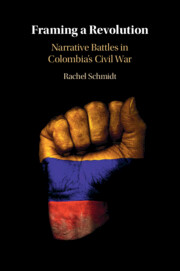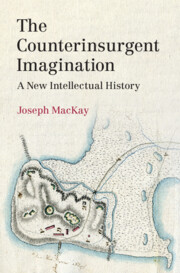Refine search
Actions for selected content:
105 results
10 - Irregular War and Warfare
- from Part II - The Traditional Security Agenda
-
- Book:
- Understanding International Security
- Published online:
- 11 October 2025
- Print publication:
- 30 October 2025, pp 191-209
-
- Chapter
- Export citation
5 - 2006
-
- Book:
- Choosing Defeat
- Published online:
- 07 October 2025
- Print publication:
- 07 October 2025, pp 133-160
-
- Chapter
- Export citation
The Enemy of My Enemy is My Friend: Transnational Ethnic Khmu Anti-Lao PDR Insurgents during the Late Cold War
-
- Journal:
- TRaNS: Trans-Regional and -National Studies of Southeast Asia , First View
- Published online by Cambridge University Press:
- 18 July 2025, pp. 1-23
-
- Article
-
- You have access
- Open access
- HTML
- Export citation
11 - Terrorism and Intrastate Conflict
-
- Book:
- Civil War and Intrastate Armed Conflict
- Published online:
- 29 May 2025
- Print publication:
- 12 June 2025, pp 341-385
-
- Chapter
- Export citation
The March 2015 Bombings of Yunnan and the Decline in Sino-Myanmar Relations 2015
-
- Journal:
- Asia-Pacific Journal / Volume 13 / Issue 14 / April 2015
- Published online by Cambridge University Press:
- 14 March 2025, e1
-
- Article
-
- You have access
- Open access
- Export citation
5 - Radical Pedagogies
- from Part II - Activism in the Lecture Hall and the School System
-
-
- Book:
- Language Activism
- Published online:
- 31 May 2025
- Print publication:
- 06 February 2025, pp 61-74
-
- Chapter
- Export citation
The Determinants of Insurgent Gender Governance
-
- Journal:
- International Organization / Volume 79 / Issue 1 / Winter 2025
- Published online by Cambridge University Press:
- 12 March 2025, pp. 36-80
- Print publication:
- Winter 2025
-
- Article
-
- You have access
- Open access
- HTML
- Export citation
Introduction
-
- Book:
- Insurgent Cultures
- Published online:
- 07 December 2024
- Print publication:
- 28 November 2024, pp 1-46
-
- Chapter
-
- You have access
- Open access
- HTML
- Export citation
Unlikely Allies: Lao Insurgent Perspectives of Armed Group Transnational Collaboration in the Emerald Triangle Region during the Third Indochina War
-
- Journal:
- TRaNS: Trans-Regional and -National Studies of Southeast Asia / Volume 13 / Issue 1 / May 2025
- Published online by Cambridge University Press:
- 26 November 2024, pp. 19-39
-
- Article
-
- You have access
- Open access
- HTML
- Export citation
Conclusion
-
- Book:
- Silencing Citizens
- Published online:
- 04 September 2024
- Print publication:
- 23 May 2024, pp 259-276
-
- Chapter
- Export citation
1 - Sovereignty in the Hills
- from Part I - Nationalist Claims-Making
-
- Book:
- States-in-Waiting
- Published online:
- 09 May 2024
- Print publication:
- 16 May 2024, pp 29-55
-
- Chapter
-
- You have access
- Open access
- HTML
- Export citation
3 - Solidarity with the Latin American Revolution
-
- Book:
- North Korea, Tricontinentalism, and the Latin American Revolution, 1959–1970
- Published online:
- 18 May 2023
- Print publication:
- 01 June 2023, pp 79-113
-
- Chapter
- Export citation
Chapter 6 - Ending Endless Wars
-
-
- Book:
- How to End a War
- Published online:
- 02 March 2023
- Print publication:
- 09 March 2023, pp 111-131
-
- Chapter
- Export citation

Framing a Revolution
- Narrative Battles in Colombia's Civil War
-
- Published online:
- 02 March 2023
- Print publication:
- 09 March 2023
3 - Civil War in Central America
- from Part II - Institutional Origins
-
- Book:
- Undermining the State from Within
- Published online:
- 23 February 2023
- Print publication:
- 02 March 2023, pp 63-88
-
- Chapter
- Export citation
Disorganized Political Violence: A Demonstration Case of Temperature and Insurgency
-
- Journal:
- International Organization / Volume 77 / Issue 2 / Spring 2023
- Published online by Cambridge University Press:
- 17 April 2023, pp. 440-474
- Print publication:
- Spring 2023
-
- Article
-
- You have access
- Open access
- HTML
- Export citation

The Counterinsurgent Imagination
- A New Intellectual History
-
- Published online:
- 18 January 2023
- Print publication:
- 05 January 2023
7 - The War and Russian Intervention (Donbas)
-
- Book:
- Ukraine's Unnamed War
- Published online:
- 15 January 2023
- Print publication:
- 05 January 2023, pp 145-170
-
- Chapter
- Export citation
Advocacy, Misdirection, Protest, and Exit: Strategies of Aspiration and Anxiety amid Crime and Conflict in Putumayo
-
- Journal:
- Latin American Politics and Society / Volume 64 / Issue 4 / November 2022
- Published online by Cambridge University Press:
- 21 October 2022, pp. 24-47
-
- Article
- Export citation
3 - Islamic versus Clan Networks: Labor Remittances, Hawwala Banking, and the Predatory State in Somalia
- from II - The Institutional Context in an Era of Abundance
-
- Book:
- Black Markets and Militants
- Published online:
- 20 August 2022
- Print publication:
- 08 September 2022, pp 128-150
-
- Chapter
-
- You have access
- Open access
- HTML
- Export citation
